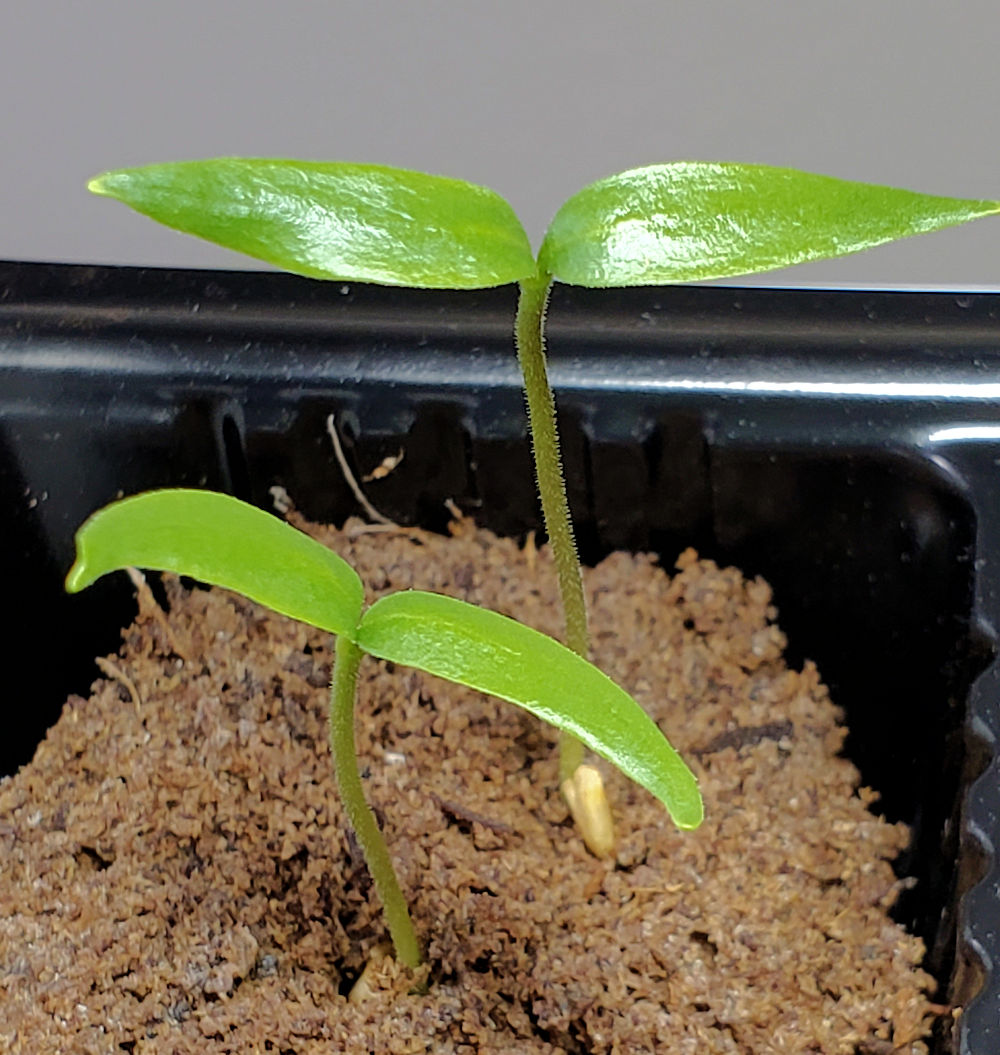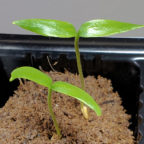Starting Pepper Plants Indoors – Seed Starting Under the Dome
Starting pepper plants indoors is really the only way to go if you plan to grow your pepper plants from seed. Unless you live in a topical location, your season probably isn’t long enough to start your seeds outside and still get ripe fruit from your plants.
Is seed starting difficult? Nope, it’s easy. You can go the route I went in the video below, or you can just use paper cups with some seed-starting mix. Either way, I think the absolute hardest thing is choosing which pepper varieties you want to grow from seed!
Starting Pepper Plants Indoors
This year (2020) I have so far planted the following pepper varieties:
- Buena Mulata: A purple-fruited cayenne type of pepper (hot). Starts as purple and ripens to red.
- Tricked You Hybrid Jalapeno: A very low-heat jalapeno, so you get the flavor without the spice. Starts out dark green and ripens to red.
- Purple Jalapeno: This jalapeno starts out purple and ripens to red. Since I also planned to grow the no-heat jalapenos, I wanted my hot variety to be a different color to easily tell them apart. Medium hot.
- NuMex Suave Orange: A very low-heat habanero; it will let you enjoy the fruity flavor of a habanero with the blistering heat. Starts green and ripens to orange.
- Bill’s Striped: An interesting striped pepper which is shaped kind of like a cone or horn. It’s striped cream and green when young, and then cream, red and darker red when ripe. Sweet.
- Giuzeppi: A Hatch chile pepper, it’s a low-heat variety. The Scoville rating is around 1,500 so it’s good for someone who like just a tiny bit of heat. Starts out green and ripens to red.
- Sweet Banana: An old favorite, sweet and no heat. They are very prolific, and I’m using it as part of an experiment. Starts out a light yellow-green and ripens to red.
- Roumanian Sweet: So far my only bell pepper of the year. Starts out a very pale green and ripens to red. Sweet.
I plan on some more, but the above are the seeds which I have started so far. I have to get these farther along so I can plant my ornamentals and maybe another cayenne-type. It’s called running out of space (yes, I planted more than just peppers, lol).
Starting Seeds Under the Dome
When starting pepper plants indoors, you’ll need your seeds, some water and your planting medium. If you want to go the paper cup route, here’s a post on how to plant pepper seeds in a cup. However, this year I’ve decided to use the Park’s BioDome for starting my seeds, and that is what you will see in the video.
You’ll notice that I also use a seed germination mat when planting pepper seeds. Most peppers like bottom warmth for germination, but if you don’t have one, just make sure you find a warm spot after you plant your seeds.
So how long does it take for pepper seeds to sprout? It depends on the variety, the warmth you can give them and the freshness of the seeds. I got lucky and almost all f them germinated within a week. The two hold-outs are the NuMex Suave Orange and the Roumanian Sweet. The NuMex Suave Orange isn’t all that surprising — it’s a capsicum chinenses, and they tend to take longer to germinate. Roumainian Sweet — well, maybe it just needs a little more coaxing to wake up from its sleep.
Starting Pepper Plants Indoors – Video
Here’s the video for planting pepper seeds in the Park’s Bio Dome. Hope you enjoy it!
Growing Peppers Indoors
Growing peppers indoors is something fun to do. You’ve likely seen something like AeroGardens, but they aren’t the only way to grow peppers inside your home. While you can go the route of an AeroGarden, with a little ingenuity you can grow your own indoor pepper plant(s)!
Supplies Needed
For a traditional indoor pepper plant setup you will need the following supplies.
- Container: a 1-gallon container is fine if you plan to grow a short plant, or if you plan to keep your plant pruned. If you have more room, try a 2- or 3-gallon container. It can be plastic, a grow bag, a self-watering container or something along those lines — just make sure the container has the appropriate drainage.
- Growing Medium: A soil less potting mix is ideal. You can buy it ready-made or create a DIY version with compost, perlite and peat moss or coconut coir. However, if you plan to just grow one or two plants, a ready-made potting mix might be easiest. Note: you may still need to add some perlite to the mix.
- Fertilizer: Organic or not? You most likely don’t want the scent of fish emulsion floating through your home, but you can try worm castings, seaweed mixes and some less-aromatic organic fertilizers. Or, you can go with something like Miracle-Gro. Or…something in between. Just make sure that the N-P-K is either quite balanced (numbers about the same) or else the last two numbers should be somewhat higher than the nitrogen.
- Water: Yep, water is obvious! Just make sure it’s warm-ish — not hot or cold. If you aren’t quite sure about the quality of your tap water, try some purified or distilled water. This is especially important if you have a water softening system that uses salt as a softener.
- Pepper Plant: Yep, you will need a pepper plant! You may want a small-ish transplant (it will probably shock less), but you can also go for a larger transplant. Or — grow your own from seed! 😀
What About Lighting?
Unless you have a large south facing window or a sunroom, you’ll probably need some sort of supplemental lighting for growing peppers indoors. While I do have a south-facing window where I grow plants, flowering and fruiting plants need more than just foliage plants.
I like LED lights myself, and I have a few scattered around. There are kinds with blue and red lights, some which have a more warm-toned (I call it yellowish) light, and some that are more like sunlight. I’ve had all three kinds, and found that they all work well, but I personally prefer the ones that are more like sunlight (white).
These days I mostly use the LED plant lights which are clip-ons with timers (3, 6 or 12 hours). They are pretty much set and forget. I think the lowest wattage I have is 50 watts, and the highest 100 watts. I’ve good results with even just the 50 watts for flowering strepocarpus plants, but if you don’t have good natural light, I’d recommend 60 to 100 watts for growing peppers indoors. These days, the LED plant lights are really inexpensive!
Varieties for Growing Peppers Indoors
What variety is best for growing peppers indoors, you may ask? You can grow just about any kind, but the best choice for you depends on what kind of peppers you like and how much space you have.
Peppers which typically grow to 12 inches or less will be easiest for most people, but if you have the room for a bigger plant…go for it! Just remember that the bigger the plant, the more light it will need.
A word about hot peppers, though (and especially the super-hots). If you have children or pets which will be around the plants, you’ll want to stick with sweet peppers, or at least those that are mild. If you don’t have to worry about small children or pets, hot is fine as long as you aren’t going to brush by them a lot. Especially when it comes to the super-hot peppers, the capsicum oil can be on the outside of the fruits, and if you get that oil on your hands, it can be an uncomfortable experience. And if you forget and rub your face…let’s not go there. Suffice to say, be very careful if you plan to grow the super-hot peppers indoors.
I’m currently in the process of growing some sweet banana peppers indoors, and I may add some Tobago Seasoning in a few more weeks. I just planted the seeds, though, so I don’t have much in the way of photos — yet! Watch for them in the coming weeks.
Meanwhile — have fun growing your own pepper plants indoors!
